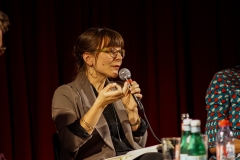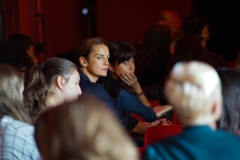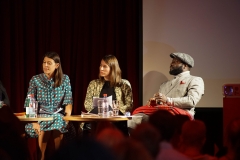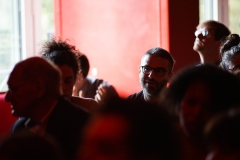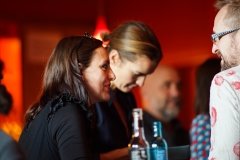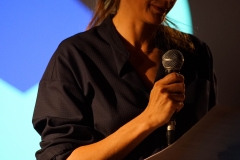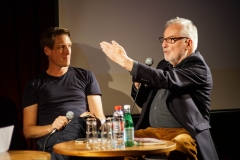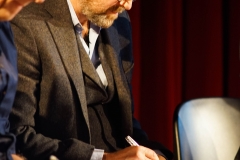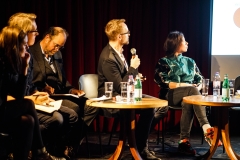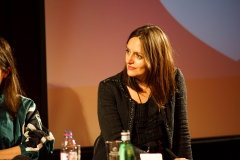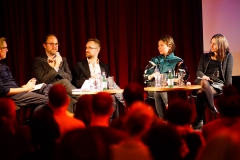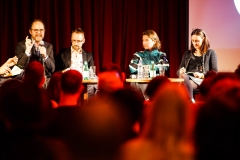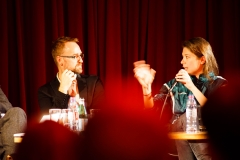Summary
BORDERLANDS. ART AND NEUROSCIENCE IN DIALOGUE
summary by Corinna Kühnapfel
The event “Borderlands. Art and Neuroscience in Dialogue” was a celebration of 10 years of AoN (AoN_Association_of_Neuroesthetics) on September 28, 2018. The AoN was founded on May 8, 2008 by Alexander Abbushi at Charité Berlin. The artistic and scientific directors of the AoN Elena Agudio and Joerg Fingerhut with generous support of the Abbushi family and the Einstein Foundation Berlin put together a programme that spanned from debates on art and psychiatry to the most recent developments in cognitive neuroaesthetics.
From 2 pm until 2 am, the event comprised 12 hours of presentations, discussions, poetry, contributions from the audience, memoirs and celebrations under the red light shine of “Roter Salon” at Volksbühne. The day in late summer started with Uljana Wolf reading her multilingual poetry, creating an aesthetic experience right at the beginning of the event, of which an aspect of it was taken up by Eugen Wassilizky. In his presentation with the title “The Power of Poetry”, he addressed the emotional power of poetic language and how experimental research can be conducted on this topic. Wassilizky and his team from the Max Planck Institute for Empirical Aesthetics used goosebumps (but also heightened skin conductance and heart rate) as indicators of emotional arousal, more specifically of being moved and experiencing pleasure from classical poetry. “Being moved” was defined as “the mixed sentiment of suffering and the pleasure taken in this suffering” by Friedrich Schiller (quoted in Menninghaus et al., 2015). In this line, fMRI experiments showed that the reward circuitry is active when reading poems, thus the combination of goosebumps and the activity of the reward system reflects that being moved is a mixed emotional state. This and further empirical experiments that were presented showed that an highly subjective experience like reading poetry is measurable in the extent of measuring peak emotional experiences in moving poetry. However, capturing the multilayered response below that “tip of the iceberg”, which is different in each and every individual and giving insights on how poetry has the capability to evoke moments of disruption still poses an exciting topic for neuropoetrics and other disciplines. In the discussion, James Wilkes who works between the discourses of neuroscience and art, together with the audience and the panelists explored the different experiences and responses with respect to classical and contemporary poems.
In the second panel, with artist Ulf Aminde, psychiatrist Ana Gomez Carillo, curator Bonaventure Ndikung and sociologist Monica Greco we investigated sanity as a social construct in the western capitalist world. This has been a concept developed by the Socialist Patients‘ Collective (SBK) founded in Heidelberg in 1970. They suggested to “turn illness into a weapon”, believing that people with illness could form a revolutionary class struggling against oppression. In this line it was discussed how madness, being mentally challenged and insanity are considered to be forms of deviations from traditional, cultural and sociological patterns due to extreme pressures from society. Following this, one could assume that madness is a cultural and social invention. The norm society creates is equivalent to sanity. In this manner, psychiatry was discussed as a normalizing disciple in which disorders are defined by socially imposed thresholds of function and dysfunction. It was recognized that those that fall out of this norm can be seen to be given special faculties or have spirits, or are people choosing to occupy spaces outside the realities of society, spaces that are valued in other cultures. Madness can be seen as a tool to resist and escape suppression. Panelists engaged critically with the title of this panel “Turning illness into a weapon”, examining it in the light of its romanticization, and pondering on the value and the suffering inherent to mental illness. The idea of turning an illness into a weapon, to counter the oppression imposed by normalizing disciplines, may be seen useful or appropriate or even inevitable; nonetheless it connotes violence, and draws a thin line between radicalization and violent radicalization. Along these lines, healing involves some process of re-normalization to re-establish function in a social setting, group finding and belonging. To that end it was stressed that it is important to look at the agendas and agencies that are involved in certain processes of normalization, and to consider in the first place the patient as a subject. A conversation that shall to be continued with a project on Ultrasanity developed by SAVVY Contemporary and in collaboration with the AoN as well.
The afternoon programme was followed by a panel dedicated to celebrate 10 years of AoN, looking back at 10 years of long-term collaborations, projects and engagements at the verge between the arts and the neurosciences with the AoN. This panel was hosted by Oliver Abbushi (chairman of the AoN) and Dada Held-Poschardt. Both reflected the work of the AoN, and especially how their personal history was interwoven with the AoN. With video messages by Vittorio Gallese, Christine Macel, Jesse Prinz, Daniel Margulies and Ida Momennejad as well as short interventions on the stage, the symposium provided an overview on the multitude of collaborators and friends the AoN has assembled over the years. Most of the contributors to this celebration also directly addressed the founder of the AoN, Alexander Abbushi, who joined the event for this panel and who was the driving force of the AoN. For many this was an opportunity to commemorate the fruitful and inspiring atmosphere he created in the early years of the AoN. Among them was Ernst Poeppel, a founding member of the AoN, who encouraged Alexander Abbushi to put his ideas into action and has been a long term collaborator of the AoN.
How could a dialogue between neuroscientists and artists be heuristic and not reductive? This is what artist Ivana Franke elaborated on her work together with neuroscientist Ida Momennejad. It became clear that there is a gap between scientists and artists in terms of methodologies but also with respect to what kind of understanding they aim to develop. Their joint AoN publication “Seeing With Eyes Closed” was aimed at not analyzing an artwork or expressing scientific content with art, but to produce knowledge about hallucinations and flickering phenomena and pose questions about visual realities. This project demonstrated the centrality of experiment and the possibility of bracketing the world, not reducing each other’s worlds but try to stay within limited space of extra-disciplinarity.
Thereafter, Warren Neidich proclaimed a manifest-like statement on neuroaesthetics, bringing criticality towards the neurosciences. He presented three categories of neuroaesthetics, which consist in an idealist, positivist and activist category. Accordingly, positivist neuroaesthetics utilizes scientific methods and neuroimaging to explain and locate the origins of artistic and cultural production in the cerebral modules in the material brain. Aesthetic products are considered objects of interest to study them in a scientific method, which is seen to be the best to investigate them. Idealist neuroaesthetics, adopting the ideas of continental philosophy, understands that creating new circuits in art means creating them concomitantly in the material brain as well. According to this approach, artistic method using materials apparatuses and methodologies generated by artistic practice have the potential to produce alternative regimes of facts. Activist neuroaesthetics is related to the idealist category but goes one step further to include it as an important tool for social and political transformation. It understands that neuroaesthetics is key to emancipatory ethics and politics. This provides the platform for a political agenda of art. It was concluded with the comment that artists create a new special language to reach meaning outside the normalized realm of interpretation, thus creating new weights and balances of neurons and synapses in the material brain.
The last panel brought together the two neuroscientists Beatriz Calvo-Merino and Ed Vessel with the philosopher Alva Noë and the artist Alexandra Pirici to discuss in which ways neuroaesthetics, art, and philosophy intersect. The role of the motor system in neuroaesthetics is the field investigated by Beatriz Calvo-Merino. In one of her studies it was found that areas of the motor system are more strongly activated when watching familiar dance movements compared to watching unknown dance movement. This finding supports a stronger internal simulation when observing other people’s movements one is familiar with. Also, it was found that sensorimotor mechanisms are modulated by how much you like the movement. “Embodied Aesthetics” describes that when we are looking at art we internally simulate the movements the artist may have done during the creation of the piece of art (e.g. the brushstrokes by a painter) (Freedberg & Gallese, 2007). In this manner, in dance, the artistic tool to produce dance is the human body. As such, dance neuroaesthetics can highlight the role of embodiment and the body when perceiving art. How other aspects besides the human body such as the context, surroundings and music make dance ecological will be an interesting inquiry for future research.
Alexandra Pirici works in the visual art context with a focus on enactment and embodiment. In her projects one idea is to use objects in aiming to remediate and materializing them, constituting a process of transformation rather than re-enactment, turning an image into enactment, and changing perspectives on those events or objects. She looks at ways in which we can change materiality and the body through which information performs. As such, the body is changing the information and becomes the meaning and the message.
Ed Vessel primarily works in visual neuroaesthetics and presented two general questions he probes and worked with. The first can be characterized by the question whether different people like the same things by the approach of measuring “shared tast”,, i.e. aesthetic preference for a large number of images. For real-world scenes it was found that objective stimulus features (e.g. golden ratio, symmetry and colors) are driving the shared taste. However, when the participants were shown the same images but with variations in such low level visual features, there was a lower shared taste. This argues that subjective factors such as personal relevance, familiarity or meaning matter even more than objective features in determining aesthetic judgements. Another interesting finding is that the default mode network (DMN), which is normally more engaged when focussing internally is also active when we look at an artwork, which we find aesthetically moving. This mechanism could be one of the hallmarks of aesthetic experience.
Philosopher and cognitive scientist Alva Noë critically discussed the “trigger conception”, which is assumed by many neuroscientists. According to this conception, artworks are stimuli that produce aesthetic experience in us. Noë argues that this is wrong from both sides: aesthetic experiences are not triggered in us and artworks are not triggers for aesthetic experience. Some considerations broadly summarized to support this claim are for example that aesthetic experiences are always multimodal, dynamic and changing, vary in a setting of conversation and criticism, and involve effort. According to Noë, aesthetic experience is something persons (not brains) undertake and they do so always in the setting of others and against a background of history and culture. As such, the trigger conception is mistaken in so far that it takes for granted that aesthetic experiences are timbale, operationalizable, stable episodes in consciousness that occur inside individuals. As this is not the case to Noë, there is no fixed data in the individual that can be studied using any methods. What we can study is what happens in the brain when we do all theses things while engaging with art (e.g. looking, thinking, describing, feeling). Art is not to trigger aesthetic experience but rather works of art provides us the opportunity to react, rethink, look, judge and also catch ourselves in these acts – art is not a trigger but an opportunity. What he then proposes is to think of an neuroaesthetics is not as neuroscience trying to explain art, but rather to be a more open field to frame a conception of ourselves. In the discussion it became clear that evaluating art is a fundamental aspect of how humans interact in the world. Aesthetic experiences are not single moments but complex and in the end the product of our minds and brains. Neuroscience and psychology may not have the tools available to measure it in the depth we would like and the aim is not to use neuroscience to understand what is good art or not, or to explain art, but we can imagine to have techniques in the future that allow us to probe deeper.
REFERENCES
Freedberg D & Gallese V (2007) Motion, emotion and empathy in esthetic experience. Trends in Cognitive Sciences 11 (5):197-203.
Menninghaus W, Wagner V, Hanich J, Wassiliwizky E, Kuehnast M, Jacobsen T (2015) Towards a Psychological Construct of Being Moved. PLoS ONE 10(6): e0128451.
LINKS
PHOTOS
Photos by Chris Holland
